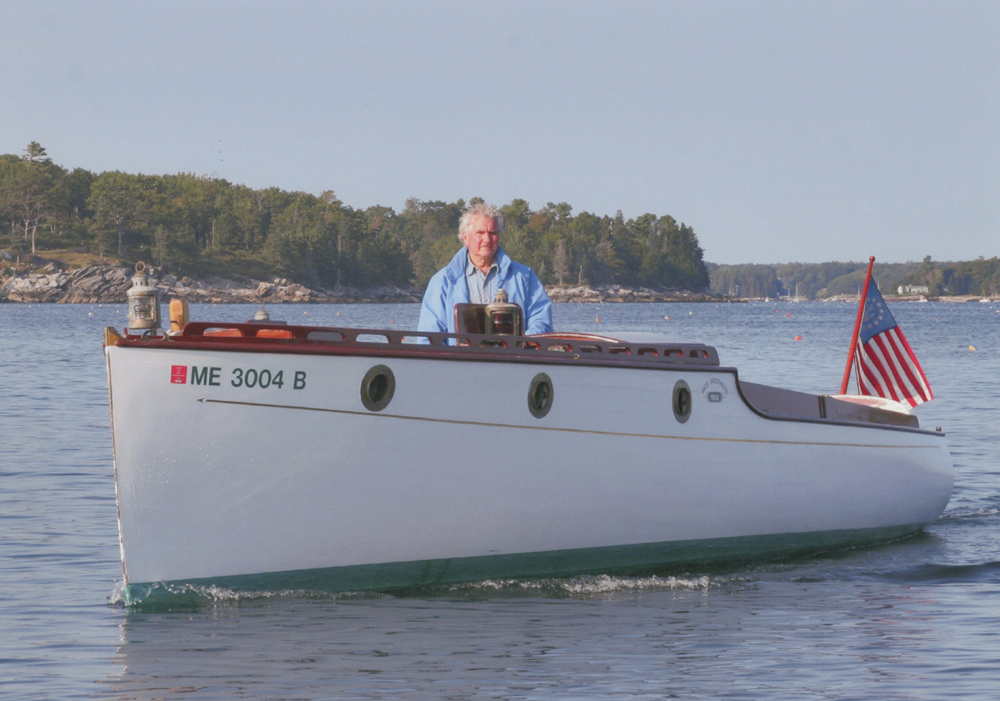
Bruce took care of DOC’S PRIDE for her owner Dr. Harold Mott-Smith, Jr. since the early ‘60s. She was built by the Rice Brothers of East Boothbay in 1908 and was featured in an article that appeared in “Yachting” magazine the same year. She was originally PATRIKOS and owned by Edgar O. Achorn. Dr. Mott-Smith, Jr. acquired a summer cottage on Clifford’s Cove on the west side of Rutherford Island in South Bristol in 1934. The same year he purchased the boat and removed the awning and name, leaving her without a name until Bruce named her DOC’S PRIDE. Bruce thought she might have had a Rice Brother’s engine, but originally she was powered with a two-cylinder Knox.
Dr. Mott-Smith Jr. is a very interesting person with a very interesting family. His grandfather was a dentist and politician in Hawaii and his father was a very well-known artist. Harold was born in Paris, France in 1897 where he would spend much of his early childhood, before coming to Schenectady, New York in 1907. When he was in France he contracted measles and the only book he could read was one on Physics, which gave him his love for science. He studied physics, mathematics, and chemistry at Cornell University and earned his bachelor’s degree in 1919. He then went to General Electric Research Laboratory and became the assistant to Dr. Irwing Langmuir, a Nobel Prize winner, who his mother knew, for the next seven years. With Dr. Langmuir they worked on understanding gas discharges, the basis for low pressure discharges. Dr. Mott-Smith, Jr.’s studies led him to the development of Thyratron, which led to the GE mercury arc power rectifier. He then went on to study quantum and nuclear physics at the Federal Technical Institute in Switzerland. Here he worked with Professor Pauli, who studied under Albert Einstein. Before he completed his studies he was asked to take a position at the University of Illinois and rebuild their physics department. While here he worked on the principles of the betatron, which was a new designed x-ray tube. Just before the onset of World War II he went to work for the Navy and was tasked with removing magnetism from their ships, known as degaussing. This process is still in use today. He also directed the construction of the first U. S. deperming station at Yorktown, VA. This station was so efficient that they could do one ship every day. Dr. Mott-Smith, Jr. than taught the first degaussing class at the Naval Warfare Station. All this time, he was operating as a civilian, but was commissioned in the Office of the Chief of Naval Operations in September 1943. Two years later he went to work for the Bureau of Ordnance and assisted in the capture and removal of the Kochiel Tunnel in Bavaria, which was rebuilt at the Naval Ordnance Laboratory in White Oak, Maryland. This facility was set up by the Germans to study high-speed guided missiles. For all his work he received a Commendation from the Secretary of the Navy.
Bruce came to know Dr. Mott-Smith, Jr. through his mother and father-in-law, the Grays. Burnham & Shew of South Bristol took care of the boat for many years and when they did not want to do it anymore, Bruce took over. He said, “I would go down there with my father-in-law, my wife’s stepfather, and we would haul it out with block and tackle for Dr. Mott-Smith had his own boat shed. The relationship grew between myself and Dr. Mott-Smith. He never married and he never had any children and his sister always said that I was probably the son he never had. When he passed away I inherited his place on the water on Damariscotta River along with the boat.”
The first year Bruce owned the boat he decided to refasten her. He said, “I had her in the water previous to that but just to make sure I refastened her with number 9 bronze screws, which the owner of Bath Rentals had purchased with all of the bronze hardware from a company in New Jersey that built PT Boats. They were just the right length number 9 wire was perfect and I figured the bronze was good because she was copper fastened. So, I re-fastened the bottom and I put four floor timbers from the steering bulkhead aft just to stiffen up the keel section because it’s a skeg boat. I stayed with gasoline engine and put a little 3-cylinder Westerbeke in her. I didn’t put her in the water for a couple years and it was on like a 20 degree angle and I didn’t realize, but the water coolant seeped into one of the cylinders and actually ate the valve right off. So, I pulled the engine and put in the 3-cylinder Universal diesel which in my way of thinking was safer.”
Like the cobbler, most boatbuilders rarely have time to go boating. Bruce said that he used the boat a lot the first year, but after that time was getting hard to find. He said, “The last time I used it was probably less than an hour. I went out around Davis Island and back to the mooring.
DOC’S PRIDE was sitting at Gamage’s Shipyard in South Bristol awaiting the arrival of CWC Boat Transport to take her to her new home at Maine Maritime Museum in Bath. Bruce said that they have told him they are going to use the boat for small charters on the river. Bruce added, “I was looking for a place where she would have a good home for her last days and she would not be out on a relict pile rotting away.”
Looking for a ride on a true classic Maine-built boat? She may not hit the water this year, since it is late in the season, but I will certainly be looking for a ride next season.



